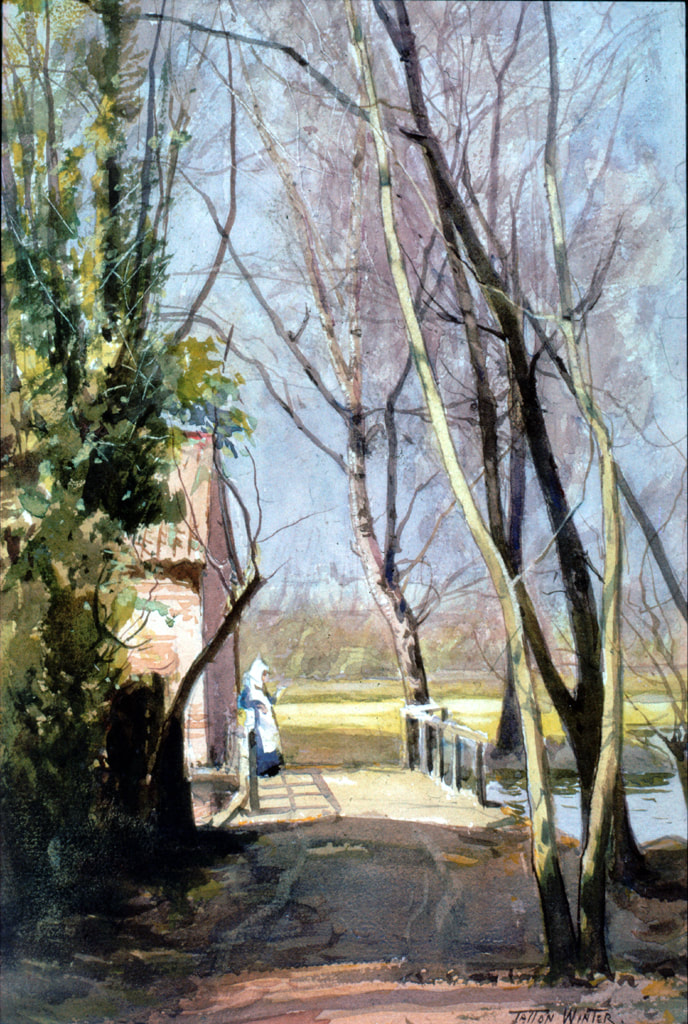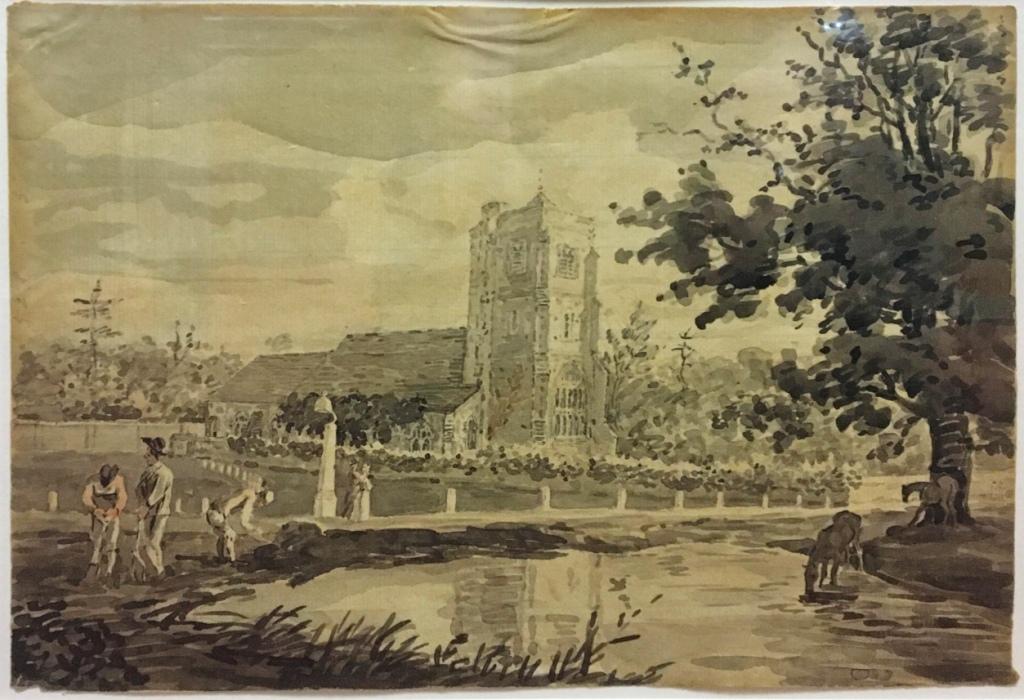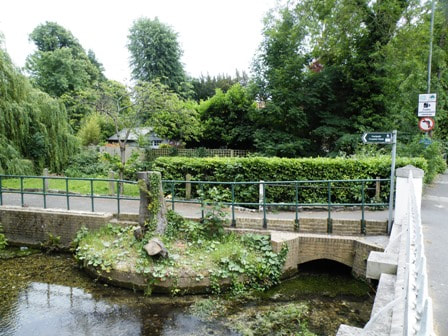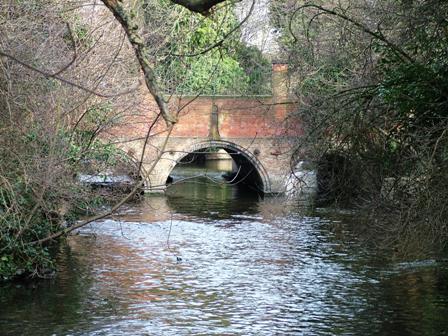The Painted Wandle -
|
The River Wandle has been an important feature of the local landscape for centuries. It has provided drinking water for people and their animals, and water for growing crops. The water has been used to power mills and support a wide range of industries over a long period. It has been used to ornament private estates and gardens, today making a beautiful scenic addition to the Borough. It also creates an important “green corridor” for wildlife, with a number of nature reserves along its length.
Nowadays the River first appears on the surface at Wandle Park in Croydon but it then goes back underground and reappears at Waddon Ponds. There are also various sources in Carshalton. It flows through Beddington, Carshalton, Hackbridge, and then on through Merton and Wandsworth, joining the river Thames at Wandsworth.
For this exhibition we have focused on the length of the river from Beddington through Carshalton to Mitcham Bridge. All the artwork displayed is from the London Borough of Sutton Museum Collection. With changes to the landscape over time, it can be difficult to place the historic painting with how the view looks today. With this in mind we have added current photographs where possible, with some historic views.
We hope that you enjoy the exhibition online and that you may be encouraged to explore the river yourselves, as we are able to get out and enjoy our parks and open spaces safely.
Some of the images below may be enlarged to varying degrees by clicking/tapping on them - the enlargements will open in a new new window; just close them to return to the main page.
Nowadays the River first appears on the surface at Wandle Park in Croydon but it then goes back underground and reappears at Waddon Ponds. There are also various sources in Carshalton. It flows through Beddington, Carshalton, Hackbridge, and then on through Merton and Wandsworth, joining the river Thames at Wandsworth.
For this exhibition we have focused on the length of the river from Beddington through Carshalton to Mitcham Bridge. All the artwork displayed is from the London Borough of Sutton Museum Collection. With changes to the landscape over time, it can be difficult to place the historic painting with how the view looks today. With this in mind we have added current photographs where possible, with some historic views.
We hope that you enjoy the exhibition online and that you may be encouraged to explore the river yourselves, as we are able to get out and enjoy our parks and open spaces safely.
Some of the images below may be enlarged to varying degrees by clicking/tapping on them - the enlargements will open in a new new window; just close them to return to the main page.
Carshalton Park in the 19th century
Artist unknown
LDSCL: CA.008
In the 19th century Carshalton Park extended all the way to the High Street. The water course in the painting is the lower part of the Grotto Canal which is now lined with houses. Carshalton Park House stood near the present junction of Carshalton Place and Brookside. It was probably built in the late 18th century and was demolished in 1927. The building in the background is the Orangery which still stands in Brookside converted into offices. The Orangery must have been built in the 18th century but when, exactly, is not known. The spire of All Saint’s Church rises behind it.
|
The Grotto Canal looking towards the site of Carshalton Park House today. The cascade on the far right can be seen near the trees on the right of the painting. The house, which stood on the corner of Brookside near the centre of this photo, was demolished in 1927.
|
The front of the Orangery in the late 19th or early 20th century.
|
Watercress beds Mill Lane on the east side of the Grove about 1888
William Tatton Winter (1855-1928)
LDSCL: CA.078
The site of this painting is in the present Grove Park. The view looks across the Wandle towards Mill Lane from the southeast bank of the river just below the water mill and the cascade.
Farm at Carshalton
Joseph Powell (c.1780-c.1834)
LDSCL: CA.178
These are from a group of drawings of Carshalton but the exact location is uncertain. The abandoned cog wheels suggest that this is a millwright’s workshop. It may be the Grove Mill which stood north of the Westcroft Sports Centre. Part of this was used for engineering but the view does not really fit other sources. A millwright called Alan Lambert had a yard in Hackbridge around this time but little is known about his works there.
Alan Lambert (thought to be 1753-1827), millwright, painted by A. Monies (dates unknown) in about 1800. The original painting is on display in the Water Industry Room, upstairs at Honeywood Museum.
LDSCL: CA.195
LDSCL: CA.195
Snuff Mill, Carshalton, 1884
William Tatton Winter (1855-1928)
LDSCL: CA.171
The upstream side of Ansell’s mill just above Butter Hill Bridge. These were probably built in the 18th century. They were used for grinding tobacco into snuff.
The Wandle at Beddington
William Henry Croot
LDSCL: B.027
Looking downstream towards the Beddington Lane Ford. This section of the river was used as a road: carts went into the water and pedestrians used the path along the bank.
North West view of Beddington Church, 1796
Artist unknown
LDSCL: B068
The water in the foreground is the end of the canal-like west lake which ornamented the front of Carew Manor to the left of the painting. Carew Manor still stands on the edge of Beddington Park, but the lake was filled in the Victorian period. The obelisk centre left supported a bell so that coaches approaching the house could announce their arrival.
Manor Cottage, Wallington about 1977
Paul Robertson (b.1931)
LDSCL: W.007
This little cottage by London Road near Wallington Bridge was formerly a lodge attached to Wallington Manor House which was demolished in 1931. The bridge carried the path into Beddington Park over the outflow from an ancient spring-fed pond. London Road is to the right.
The scene today.
The Wandle near Beddington Corner
William Tatton Winter (1855-1928)
LDSCL: W.017
This probably shows the river at Bennet’s Hole in what is now Poulter Park opposite the Willow Lane industrial estate. The land area still looks rural, but the riverbanks are now covered with scrub and small trees.
The Wandle at Bennet’s Hole. It is not known who Bennet was – the name dates back to at least the early 17th century.
Robert’s Mill, Beddington Corner
Winifred Madder (1883-1972)
LDSCL: W.006
This long-established leather mill stood on a large island immediately upstream of the Goat Road bridge at Mill Green. It was operated by HD Roberts from about 1880. The mill site is now a small industrial estate and the scene is hardly recognisable.
Robert’s Mill, Beddington Corner
Winifred Madder (1883-1972)
LDSCL: W.004
This is the entrance bridge to the mill site which crosses a backwater of the Wandle just above the Goat Road bridge. There is still a bridge on the site but the scene is hardly recognisable.
The bridge today. It is now surrounded by trees so it is impossible to see from the angle painted by Madder.
The Old Tannery
William Tatton Winter (1855-1928)
LDSCL: M.010
This may be the tannery on the west side of the river below the Goat Road bridge. However, the building has been demolished and there are very few photographs of it. It is difficult to fit the painting to the topography of the site, so the identification is uncertain.
Acknowledgements:
The images of all artworks and historic scenes are courtesy of London Borough of Sutton Cultural Services (Archives and Heritage). For any queries regarding reproduction permissions, please enquire here.
The modern images are Copyright © John Phillips 2020, and are used here with his kind consent.
This exhibition is the result of a collaborative project between London Borough of Sutton Cultural Services and The Friends of Honeywood Museum.
The images of all artworks and historic scenes are courtesy of London Borough of Sutton Cultural Services (Archives and Heritage). For any queries regarding reproduction permissions, please enquire here.
The modern images are Copyright © John Phillips 2020, and are used here with his kind consent.
This exhibition is the result of a collaborative project between London Borough of Sutton Cultural Services and The Friends of Honeywood Museum.
If you enjoyed this page you might like to view.......

















































